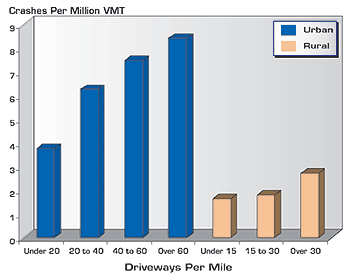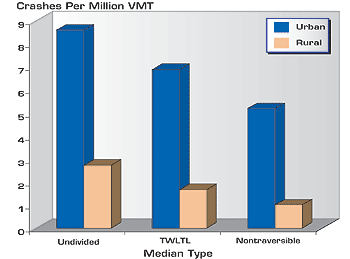
| Sip to Content |
||
 |
||
Benefits of Access Management BrochurePurpose of the BrochureThis brochure serves as a guide to the major benefits of several access management techniques in use across the United States. The purpose of this brochure is to provide a comprehensive and succinct examination of the benefits of access management and address major concerns that are often raised about access management. The benefits usually identified with access management include improved movement of through traffic, reduced crashes, and fewer vehicle conflicts. Most major concerns about access management relate to potential reductions in revenue to local businesses that depend on pass-by traffic. This brochure does not describe the precise strategies that transportation departments should follow to implement an access management program, but rather provides an introduction to the key concepts. The brochure may also be a useful tool to distribute at public meetings for both general access management plans and specific applications of access management techniques. This brochure describes the relevant benefits and issues with three key sets of access management techniques:
What is Access Management?Access management is a set of techniques that state and local governments can use to control access to highways, major arterials, and other roadways. Access management includes several techniques that are designed to increase the capacity of these roads, manage congestion, and reduce crashes.
State, regional, and local governments across the United States use access management policies to preserve the functionality of their roadway systems. This is often done by designating an appropriate level of access control for each of a variety of facilities. Local residential roads are allowed full access, while major highways and freeways allow very little. In between are a series of road types that require standards to help ensure the free flow of traffic and minimize crashes, while still allowing access to major businesses and other land uses along a road. Access SpacingSignal Spacing
A major synthesis of research on access management found that each additional signal over two per mile (i.e., a one-half mile signal spacing) increased travel time by over six percent. [4] A study of an intersection in Cincinnati where a signal was added found a 20 percent increase in peak travel times. [11] A demonstration project in Colorado revealed that half mile signal spacing and raised medians on a five-mile roadway segment reduced total hours of vehicle travel by 42 percent and total hours of delay by 59 percent, compared to quarter mile signal spacing. [1] 
Improved speeds and travel times translate directly into environmental benefits. An ongoing study in Texas found that a ten mile four-lane arterial with one-half mile signal spacing reduced fuel consumption by 240,000 gallons from increased speed and 335,000 gallons from reduced delay, compared to quarter mile signal spacing. [14] Increasing the distance between signals also reduces the incidence of crashes. A review of crash data from seven states demonstrated that the crash rate increased substantially with additional signals per mile. [4] This is partly related to access spacing, which is presented next. Driveway Spacing
Appropriate driveway spacing presents another major access issue. Large numbers of driveways increase the potential conflicts on the road. Fewer driveways spaced further apart allow for more orderly merging of traffic and present fewer challenges to drivers. The congestion impacts of reduced driveways are fairly clear. It is impossible for a major arterial or highway to maintain free flow speeds with numerous access points that add slow moving vehicles. A research synthesis found that roadway speeds were reduced an average of 2.5 miles per hour for every 10 access points per mile, up to a maximum of a 10 miles per hour reduction (at 40 access points per mile). [4] With higher numbers of access points, congestion will increase significantly. An overabundance of driveways also increases the rate of car crashes. An examination of crash data in seven states indicated found a strong linear relationship between the number of crashes and the number of driveways. Rural areas had a similar, but less strong relationship. [4,7] Related TechniquesAccess management includes more techniques than can be discussed in a single brochure. Some of these techniques are newer and have been researched somewhat less. Frontage roads have been the subject of some debate in the literature, but there is no clear indication of their benefits. Other techniques, such as the relationship between highway interchange spacing and local traffic, are new topics that require more research. Many cities and states develop access management programs to deal with existing issues of congestion and safety. An active access management program, however, would need to include changes to local land use policies that encourage the rational development of major roads. In newly developing areas, land use and zoning controls that limit the number of access points and leave space for median improvements can save money and effort as these areas develop. Turning LanesLeft Turns
Exclusive turning lanes for vehicles remove stopped vehicles from through traffic. Left-turn lanes at intersections substantially reduce rear-end crashes. A major synthesis of research on left-turn lanes demonstrated that exclusive turn lanes reduce crashes between 18 to 77 percent (50 percent average) and reduce rear-end collisions between 60 and 88 percent. [4] Left-turn lanes also substantially increase the capacity of many roadways. A shared leftturn and through lane has about 40 to 60 percent the capacity of a standard through lane. [4]. A synthesis of research on this topic found a 25 percent increase in capacity, on average, for roadways that added a left-turn lane. [13] Indirect TurnsSome of the biggest issues with managing access come at intersections where vehicles must cross traffic. Some states and cities have adopted indirect turns to reduce these conflicts. In New Jersey, the jug-handle left turn requires a right turn onto a feeder street, followed by a left onto a cross street. Detroit has extensively used an indirect U-turn that requires a U-turn past an intersection, followed by a right turn instead of a regular left turn. Like dedicated left-turn lanes, indirect turns reduce crashes, improve congestion, and add capacity. Crashes decline by 20 percent on average, and 35 percent if the indirect turn intersection is signalized. Capacity typically shows a 15 to 20 percent gain. [4]
Right Turns
Right-turn lanes typically have a less substantial impact on crashes and roadway capacity than other types of turn strategies, because there are fewer limitations on right turns. Though there are fewer studies of these impacts, there is a clear relationship between the number of vehicles attempting a right turn in a through traffic lane and its delay to through traffic. This relationship is exponential – each additional car that must wait for a right turn will increase the delay more than the previous car. At intersections with substantial right-turn movements, a dedicated right-turn lane segregates these cars from through traffic and increases the capacity of the road. Roundabouts
Median TreatmentsMedians
Median treatments for roadways represent one of the most effective means to regulate access, but are also the most controversial. The two major median treatments include two-way left turn lanes (TWLTL) and raised medians. The safety benefits of median improvements have been the subject of numerous studies and syntheses. Studies of both particular corridors and comparative research on different types of median treatments indicate the significant safety benefits from access management techniques. According to an analysis of crash data in seven states, raised medians reduce crashes by over 40 percent in urban areas and over 60 percent in rural areas. [4] A study of corridors in several cities in Iowa found that two-way left-turn lanes reduced crashes by as much as 70 percent, improved level of service by one full grade in some areas, and increased lane capacity by as much as 36 percent. [5] Raised medians also provide extra protection for pedestrians. A study of median treatments in Georgia found that raised medians reduced pedestrian-involved crashes by 45 percent and fatalities by 78 percent, compared to two-way left-turn lanes. [12]
Business Concerns
Installing raised medians often raises serious concerns by the business community that local businesses that depend upon pass-by traffic (especially gas stations and fast-food restaurants [10]) will be adversely affected by medians. Though there are few studies of the actual impacts of medians on business sales, there are several surveys of business owner opinions. Surveys conducted in multiple corridors in Texas, Iowa, and Florida demonstrate that the vast majority of business owners believe there have been no declines in sales, with some believing there are actually improvements in business sales. [2,5,8] One study in Texas indicated that corridors with access control improvements experienced an 18 percent increase in property values after construction. [2] Citations
For More Informationhttp://www.accessmanagement.info
|
|||||||
| US DOT Home | FHWA Home | Operations Home | Privacy Policy | |||||||